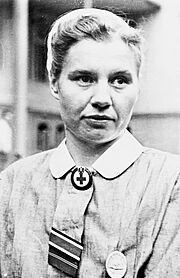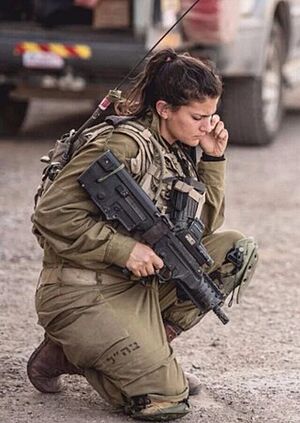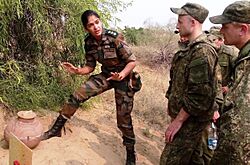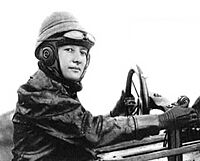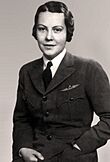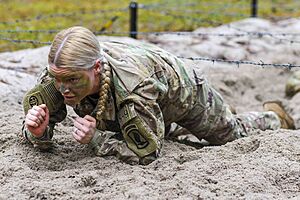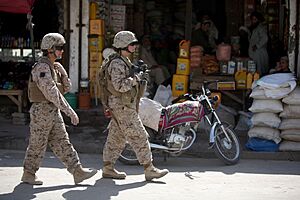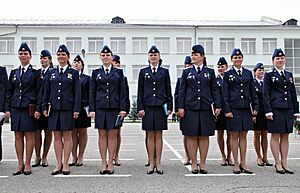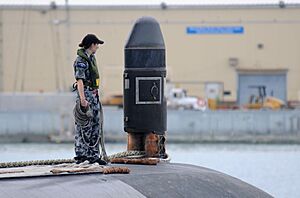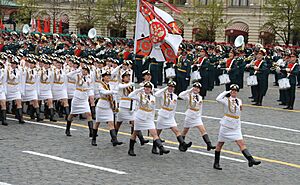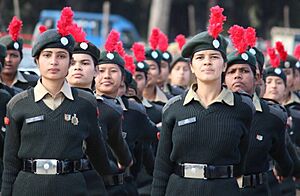Women in the military facts for kids
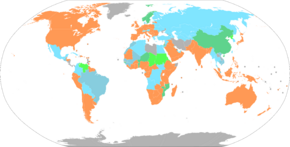
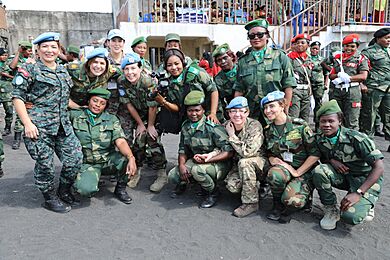
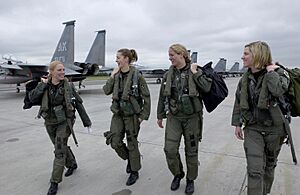
Women have been serving in the military since the inception of organized warfare, in both combat and non-combat roles. Their inclusion in combat missions has increased in recent decades, often serving as pilots, mechanics, and infantry officers.
Since 1914, women have been conscripted in greater numbers, filling a greater variety of roles in Western militaries. In the 1970s, most Western armies began allowing women to serve on active duty in all military branches. In 2006, eight countries (China, Eritrea, Israel, Libya, Malaysia, North Korea, Peru, and Taiwan) conscripted women into military service. In 2013, Norway became the first NATO country to draft women, as well as the first country in the world to conscript women on the same formal terms as men. Sweden followed in 2017, as did the Netherlands in 2018 (although in the Netherlands there is no active peacetime conscription). Denmark announced in 2024, that women will be conscripted, starting in 2026.
As of 2022, only three countries conscripted women and men on the same formal conditions: Norway, Sweden, and the Netherlands. Denmark has plans to start conscripting women in 2026. A few other countries have laws allowing for the conscription of women into their armed forces, though with some differences such as service exemptions, length of service, and more.
Today women can serve in every position in the French military, including submarines and combat infantry. They make up around 15% of all service personnel in the combined branches of the French military. They are 11% of the Army forces, 16% for the Navy, 28% of the Air Force and 58% of the Medical Corps. So women are as important as men in either medics or combat.
History
World War I
United States
During the First World War, women in the United States joined organizations such as the Committee on Public Information to educate people about the war. This committee also promoted nationalism. Many women became YWCA members and went overseas to help soldiers. Women of all classes contributed to the war effort. Upper-class women founded many voluntary war organizations while middle and lower-class women worked in these organizations as nurses or by filling in open positions left by those who had gone to war.
Russia
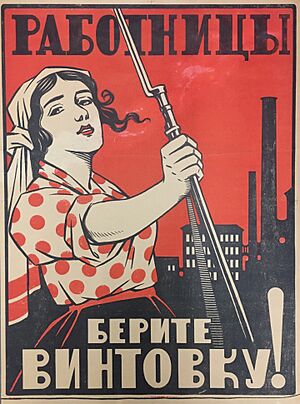
Russia is the only nation to deploy female combat troops in substantial numbers. Historically, female recruits either joined the military in disguise or were tacitly accepted by their units. Perhaps the most prominent was a contingent of front-line light cavalry in a Cossack regiment commanded from 1915 to 1917 by a female colonel, Alexandra Kudasheva (1873–1921?). This cavalry regiment fought in WWI and also during the Russian Revolution. and may have been the first gender-integrated regiment in Russian history. She was also noted for her endurance riding feats.
Others included Maria Bochkareva, who was decorated three times and promoted to senior NCO rank, while The New York Times reported that a group of twelve schoolgirls from Moscow had enlisted together disguised as young men. In 1917, the Provisional Government raised a number of "Women's Battalions", with Maria Bochkareva given an officer's commission in command. They were disbanded before the end of the year. In the later Russian Civil War, they fought both for the Bolsheviks (infantry) and the White Guard.
Others
In Serbia, some women played key military roles. Scottish doctor Elsie Ingles coordinated a retreat of approximately 8,000 Serbian troops through Romania and revolutionary Russia, up to Scandinavia, and finally onto transport ships back to England. Milunka Savić enlisted in the Serbian army in place of her brother. She fought throughout the war, becoming one of the most decorated women in military history.
In 1917, Loretta Walsh became the first woman to enlist openly as a woman. A 1948 law made women a permanent part of the military services. In 1976, the first group of women were admitted into a U.S. military academy. Approximately 16% of the 2013 West Point class consisted of women. In the 1918 Finnish Civil War, more than 2,000 women fought in the Women's Red Guards.
During the Spanish Civil War, thousands of women fought in mixed-gender combat and rearguard units, or as part of militias.
Second Sino-Japanese War
Several women's battalions were established in China during the Second Sino-Japanese War. These included the Guangxi Women's Battalion, the Yunnan Women's Battlefield Service Unit, Zhejiang Women's Guerrilla Band, Hunan War Service Corps, and others.
World War II
All the major participating nations in World War II enlisted women. The majority served in nursing and clerical or support roles. Over 500,000 women had combat roles in anti-aircraft units in Britain and Germany, as well as front-line units in the Soviet Union.
United States
During World War II in 1941, there was a total of 350,000 women who served in the united States Armed Forces. Women weren't thought to be qualified during these times, however due to the situation the United States was in decided to have women work in air craft factories and making weapons and submarines with lower pay than men.
India
In 1942, the Indian National Army (Azaad Hind Fauj) established Rani of Jhansi Regiment, India's first all-women regiment to fight for Indian independence under the leadership of Subash Chandra Bose, with Japanese assistance. It is estimated that over 1,000 women served in the regiment.
United Kingdom
In 1938, the British established uniformed services for women (small units of nurses had long been in service). In late 1941, Britain began conscripting women, sending most into factories and some into the military, especially the Auxiliary Territorial Service (ATS) attached to the army. The ATS began as a women's auxiliary in 1938. In 1941, the ATS was granted military status, although women received only two-thirds of male pay. Women had a well-publicized role in handling anti-aircraft guns against German planes and V-1 missiles. Prime Minister Winston Churchill's daughter was there, and he said that any general who saved him 40,000 fighting men had gained the equivalent of a victory. By August 1941, women were operating fire-control instruments; although they were never allowed to pull the trigger, since killing the enemy was considered too masculine. By 1943, 56,000 women were in Anti-Aircraft Command, mostly in units close to London where they faced a risk of death, but not of capture. The first death of a woman in Anti-Aircraft Command occurred in April 1942.
Germany
The Third Reich had similar roles for women. The SS-Helferinnen were regarded as part of the SS if they had undergone training at a Reichsschule SS. All other female workers were contracted to the SS and chosen largely from concentration camps. Women served in auxiliary units in the navy (Kriegshelferinnen), air force (Luftnachrichtenhelferinnen) and army (Nachrichtenhelferin).
In 1944-45 roughly 500,000 women were volunteer uniformed auxiliaries in the German armed forces (Wehrmacht). Approximately the same number served in civil aerial defense. 400,000 volunteered as nurses and many more replaced drafted men in the wartime economy. In the Luftwaffe, women served in combat roles helping to operate anti-aircraft systems to shoot down Allied bombers. By 1945, German women held 85% of the billets as clerics, accountants, interpreters, laboratory workers and administrative workers, together with half of the clerical and junior administrative posts in high-level field headquarters.
The German nursing service consisted of four main organizations: one for Catholics, one for Protestants, the secular DRK (Red Cross), and the "Brown Nurses" for committed Nazi women. Military nursing was primarily handled by the DRK, which came under partial Nazi control. Front line medical services were provided by male medics and doctors. Red Cross nurses served widely within the military medical services, staffing the hospitals close to the front lines and at risk of attack. Two dozen nurses were awarded the Iron Cross for heroism under fire.
Hundreds of women auxiliaries (Aufseherin) served in the SS in the camps, the majority of which were at Ravensbrück.
In Germany, women worked and were told by Hitler to produce more pure Aryan children to fight in future wars.
Women also fought in the Volkssturm near the end of World War Two. Girls as young as 14 years were trained in the use of small arms, panzerfaust, machine guns, and hand grenades from December 1944 through May 1945.
Japanese American Women
During the Second World War, many Japanese American women lost their jobs or pay because they were sent to relocation camps. Japanese immigrants and Japanese Americans were faced with discrimination. Many Americans called it the "yellow peril" and called Japanese people "japs". In 1913, California passed the Alien Land Law which prohibited "aliens ineligible for citizenship" from owning land to grow crops on. Despite the discrimination, many Japanese American women volunteered to serve in the Women's Auxiliary Army Corps. Japanese American women were able to greatly help the United States. Many women were hired as interpreters, translators, and interrogators in the Military Intelligence Service. In 1948, the Women's Army Corps was permanently established and remained until 1978 when women were allowed into the army.
Italy
In Italy, during the second world war, the Female Auxiliary Service (Italian: Servizio Ausiliario Femminile, SAF) was a women's corps of the armed forces of the Italian Social Republic, whose components, all voluntary, were commonly referred to as auxiliaries. The commander was the Brig. Gen. Piera Gatteschi Fondelli.
Yugoslav Partisans
The Yugoslav National Liberation Movement had 6,000,000 civilian supporters; its two million women formed the Antifascist Front of Women (AFŽ), in which the revolutionary coexisted with the traditional. The AFŽ managed schools, hospitals and local governments. About 100,000 women served with 600,000 men in Tito's Yugoslav National Liberation Army. It stressed its dedication to women's rights and gender equality and used the imagery of folklore heroines to attract and legitimize the fighters. After the war, although women were relegated to traditional gender roles, Yugoslavia's historians emphasized women's roles in the resistance. After Yugoslavia broke up in the 1990s, women's contributions to the resistance were forgotten.
Jewish Parachutists of Mandate Palestine
The Jewish Parachutists of Mandate Palestine were a group of 250 Jewish men and women from the Yishuv communities in Mandatory Palestine. The group members would go to missions run by British organisations MI9 and the Special Operations Executive (SOE) involving parachuting into German-occupied Europe. The group had women and man and one of her most known members were Chana Senesh and Haviva Reik whom were subsequently executed.
Vietnam War
Though relatively little official data exists about female Vietnam War veterans, the Vietnam Women's Memorial Foundation estimates that approximately 11,000 military women were stationed in Vietnam during the conflict. Nearly all of them were volunteers, and 90 percent served as military nurses, though women also worked as physicians, air traffic controllers, intelligence officers, clerks and other positions in the U.S. Women's Army Corps, U.S. Navy, Air Force and Marines and the Army Medical Specialist Corps. In addition to women in the armed forces, an unknown number of civilian women served in Vietnam on behalf of the Red Cross, United Service Organizations (USO), Catholic Relief Services and other humanitarian organizations, or as foreign correspondents for various news organizations.
In addition to the U.S. military women who served in Vietnam, an unknown number of female civilians willingly gave their services on Vietnamese soil during the conflict. Many of them worked on behalf of the American Red Cross, Army Special Services, United Service Organizations (USO), Peace Corps, and various religious groups such as Catholic Relief Services.
Democratic Republic of the Congo
The Democratic Republic of the Congo began training an initial 150 women as para-commandos for the Armée Nationale Congolaise in 1967. Many more were trained subsequently, over a period of years. The women received parachute and weapons training, although it is unclear to what extent they were actually integrated into the combat units of the Congo.
Eritrea
In 1999, the BBC reported that about a quarter of the Eritrean soldiers in the Eritrean–Ethiopian War were women.
Israel
Mandatory conscription for single and married women without children began in 1948. Initially, women conscripts served in the Women's Army Corps, serving as clerks, drivers, welfare workers, nurses, radio operators, flight controllers, ordnance personnel, and instructors. Roles for women beyond technical and secretarial support began opening up in the late 1970s and early 1980s. In 2000, the Equality amendment to the Military Service law granted equal opportunities in the military to women found physically and personally suitable for a job. Women started to enter combat support and light combat roles in a few areas, including the Artillery Corps, infantry units and armored divisions. A few platoons named Carakal were formed for men and women to serve together in light infantry. Many women joined the Border Police.
Despite these changes, as of 2014, fewer than 4 percent of women service members were in combat positions such as infantry, crew of tanks or other armored vehicles, artillery guns service, fighter pilots, etc. Rather, they are concentrated in "combat-support".
In 2023, the mostly-female Caracal battalion was involved in intense fighting when Hamas militants infiltrated the border area near Gaza in October 2023. The female soldiers battled militants for nearly four hours as part of the broader effort to repel the incursion. By some accounts, they played a decisive part in the clashe. None of the female combat soldiers were killed during the engagement, which has been characterized as a validation of their abilities. The unit's performance in real-world combat against Hamas is also seen as proof that women can execute infantry missions effectively when given the requisite training.
Gulf War
In 1990 and 1991, some 40,000 American military women were deployed during the Gulf War operations Desert Shield and Desert Storm; however, no women served in combat. A policy enacted in 1994 prohibited women from assignment to ground combat units below the brigade level.
21st century
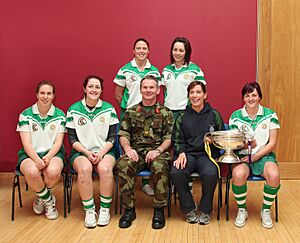
The proportion of female military personnel varies internationally, with approximately 3% in India, 10% in the UK, 15% in France, 13% in Sweden, 16% in the US, 15.3% in Canada, and 27% in South Africa. While a marginal percentage of women are reported in military service globally, estimates following the increasing trend of military women capped predictions at about 10% for 1980.
In 2021, the Nigerian Army deployed 300 female soldiers to secure Kaduna-Abuja expressway.
Combat
Some nations allow female soldiers to serve in certain combat arms positions. Others exclude them for various reasons, including physical demands and privacy policies. Among the NATO nations, and as of the mid-1970s, women were able to attain military status in the following countries: Belgium, Canada, Denmark, France, the Federal Republic of Germany, Greece, the Netherlands, Norway, Portugal, Turkey, the United Kingdom, and the United States.
Non-conscription countries, notably the United States, the United Kingdom, and Canada, are where the highest levels of female military presences have been achieved. Canada is marked as particularly progressive in its early implementation of gender equality practices. A rise in the call for equal opportunity coupled with the decline of able-bodied men willing to enter military service coaxed countries to reform policies toward female inclusion. With the opening of submarine service in 2000, women had free rein to enlist in any kind of military service.
United States
The United States military opens all positions to women. Units such as Special Operations require members to meet extraordinary requirements, and very few women have met them. As of 2024, it is reported that three women have completed the Army's elite Special Forces course, two have completed Navy Special Warfare Training to become a Naval Special Warfare combatant-craft crewman, one has completed the Air Force special tactics courses necessary to become a Combat Controller, three have completed the Air Force training necessary to become a Tactical Air Control Party airman, and one has completed the Air Force's elite Special Reconnaissance course.
Women have not historically been required to register for Selective Services; however, federal judge Gray Miller of the United States District Court for the Southern District of Texas, ruled on February 2, 2019 that an all-male draft is unconstitutional. The issue was brought when Marc Angelucci sued the Selective Service on behalf of the National Coalition for Men. Subsequently, the Fifth Circuit overturned Miller's ruling, sending the case to the Supreme Court who would refuse to hear it. June 2021, Supreme Court Justices Sotomayor, Breyer, and Kavanaugh authored an opinion stating the draft to be likely unconstitutional, and under review since 2016, by Congress and the National Commission on Military, National, and Public Service.
History
Women have been involved in the U.S. military since 1775, originally in the civilian fields of nursing, laundering, mending clothing and cooking.
Deborah Sampson was one of the first women to enlist while disguised as a man. She was unhappy with her limited role in the American Revolution. She served in a light infantry unit, fighting in many battles. Injuries put her in a hospital where her secret was discovered. Her commanding officer, General John Paterson, honorably discharged her and thanked her for her service.
Many women contributed to the American Civil War, through nursing, spying, and fighting on the battlefield. For example, Belle Royd began her career as a spy and messenger at age 17. By age 20, she became famous in the United States and was dubbed the Cleopatra of the Confederacy. As a spy, she provided confederate leaders with valuable information. She was arrested multiple times and imprisoned. Eventually, she was banished from federal soil and was told she would receive a death sentence if she were caught on federal soil again. Those who fought in the war disguised themselves as males and went by men's aliases. It wasn't difficult for women to conceal their true identities because soldiers showered separately and were fully clothed the majority of the time. In addition, both men and women would join the army with no previous military experience, so their training was very similar and the women would not stand out.
Sophronia Smith Hunt disguised herself as a man and served at the Battle of Jenkins' Ferry. She fought alongside her first husband, who was wounded in the battle and later died.
The most common way for women to be discovered was through injury. For instance, in 1861, Mary Owens claims to have enlisted in the Union Army disguised as the "brother" of William Evans, who she was in a romantic relationship with. To avoid combat, Owens claimed she took the job of delivering handwritten messages to commanders on the battlefield. After her lover was killed in battle, Mary said she decided to avenge his death by fighting on the battlefield. She sustained an injury to her forehead and was sent to the hospital for treatment, where her female identity was revealed. She was discharged from the military. Those who were discovered would either be sent home or punished. Mary was supposedly warmly welcomed back into her town. There is evidence, however, that this account has since been debunked.
Other disguised women were often uncovered by chance. Sarah Collins was a strong woman who believed she could do the job of a male soldier. Her brother, also a soldier, assisted her in disguising as a man by cutting her hair short and dressing her up in men's apparel. Her true identity was discovered due to her improperly placing her shoes. Sarah was then sent home while her brother remained fighting. It is difficult for historians to estimate the true number of women who fought in the war because of their disguises and aliases, as well as their desire for discretion. Women joined the fray of the Civil War for similar reasons as men: the promise of a steady wage, innate sense of patriotism, or the thrill of an adventure. Some women would even follow their loved ones into battle.
In 1917, Loretta Walsh became the first woman to enlist openly as a woman when she join the Navy. A 1948 law made women a permanent part of the military services. In 1976, the first group of women was admitted into a U.S. military academy. Approximately 16% of the 2013 West Point class consisted of women.
In 1990 and 1991, some 40,000 American military women were deployed during the Gulf War operations Desert Shield and Desert Storm; however, no women served in combat. A policy enacted in 1994 prohibited women from assignment to ground combat units below the brigade level.
Policy changes
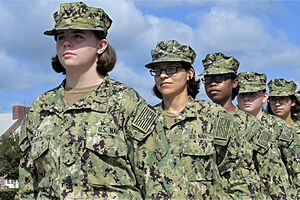
Until 1993, 67 percent of the positions in the Army were open to women.
In 2013, 15.6 percent of the Army's 1.1 million soldiers, including National Guard And Reserve, were female, serving in 95 percent of occupations. As of 2017, 78 percent of the positions in the Army were open to women. It was only in 2015 that the Department of Defense dropped its ban on women in combat roles, and integration of women into these MOS's has been slow. In the U.S. Air Force, in 2015, 99% of career fields are open to women, with the exceptions of Special Tactics Officer, Combat Control, Special Operations Weather Technician, Combat Rescue Officer, Pararescue and Tactical Air Control Party.
In 2013, female US Army soldiers enrolled in a training course designed by Combined Joint Task Force Paladin, specifically designed for Female Engagement Team members. The course was intended to train female soldiers for tasks such as unexploded ordnance awareness, biometrics, forensics, evidence collection, tactical questioning, vehicle and personnel searches, and homemade explosive devices.
By May 2015, none of the nineteen women vying to become the first female Army Rangers had passed Ranger School. Eleven of the nineteen dropped out in the first four days. Of the remaining eight who failed in the next step, three were given the option to restart from the beginning. Two graduated in August 2015. A third graduated in October 2015.
In April 2015, the Marine Corps' Infantry Officer Course, which had been gender-integrated for two and a half years for research purposes, ended without a single female graduate. The final two participants failed the initial Combat Endurance Test.
In 2016, Secretary of Defense Ash Carter opened all military occupations to women, without exception. This opened up the roughly 10% of all military jobs that had previously been closed to women, including positions in infantry, armor, reconnaissance, and some special operations units.
Women have been injured, killed, and awarded high honors. Two women received the Silver Star for their actions in combat: Sergeant Leigh Ann Hester in 2005 and Army Specialist Monica Lin Brown in 2007. Over 10,000 combat action badges were awarded to women who served in combat in Iraq and Afghanistan.
In 2022, the United States Army revised its 40-year-old fitness test – the Army Physical Fitness Test – with the new Army Combat Fitness Test. The test originally included leg tucks and was graded on an even field between age and gender. These factors lead to a low portion of female soldiers meeting adequate fitness scores, with 44% failing. The Army since updated the exam, replacing leg tucks with a plank and grading based on a matrix which accounts for age and gender. This policy change allowed a majority of female soldiers to meet standards and set a precedent for breaking uniformity in expectations.
In February 2023, a series of new policies were published by the US Defense Department in order to support military members.
Physical, social, and cultural issues
A 2015 Marine Corps study found that women in a unit created to assess female combat performance were significantly injured twice as often as men, were less accurate with infantry weapons, and were less skilled at removing wounded troops from the battlefield.
The study assessed a nine-month experiment at Camp Lejeune, North Carolina, and Twentynine Palms, California. About 400 Marines, including 100 women, volunteered to participate.
Male squads, teams, and crews demonstrated better performance on 93 of 134 tasks evaluated (69 percent) than units with women in them. Male units were faster while completing tactical movements in combat situations, especially in units with large "crew-served" weapons such as heavy machine guns and mortars. Male infantry squads had better accuracy than squads with women in them, with "a notable difference between genders for every individual weapons system" used by infantry rifleman units. The M4 carbine, M27 infantry automatic rifle, and M203 single-shot grenade launcher were assessed.
Male Marines who had not received infantry training were more accurate than women who had received training. In removing wounded troops from the battlefield, "notable differences in execution times were found between all-male and gender-integrated groups".
Unit cohesion was lower in mixed-gender units.
Women on submarines
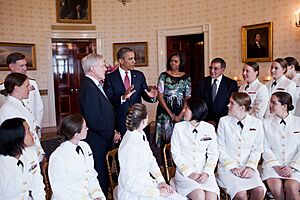
In 1985, the Royal Norwegian Navy became the first navy in the world to permit female personnel to serve in submarines. The first female submarine commander was Captain Solveig Krey aboard the first Kobben class submarine on September 11, 1995. The Danish Navy allowed women on submarines in 1988, the Swedish Navy in 1989, followed by the Royal Australian Navy in 1998, Canada in 2000 and Spain.
On April 29, 2010, the United States Navy authorized women to serve aboard submarines. Previously, objections such as the need for separate accommodation and facilities (estimates that modifying submarines to accommodate women would cost $300,000 per bunk versus $4,000 per bunk on aircraft carriers) had prevented the change. The Navy stated that larger SSGN and SSBN submarines had more available space and could accommodate female officers with little/no modification. Qualified female candidates with the desire to serve were available. (Women then represented 15 percent of active duty sailors and were earning about half of all science and engineering bachelor's degrees.)
In May 2014, it was announced that three women had become the UK Royal Navy's first female submariners.
On November 15, 2017, the first Argentinean female submarine officer, Eliana Krawczyk, disappeared in the Atlantic Ocean after the Argentine Navy lost contact with the submarine ARA San Juan after a reported failure in the electric system. As one of the 44 crew members lost at sea, Krawczyk was honored by the country's Jewish community as "La Reina De Los Mares" on International Women's Day in 2018.
On July 4, 2017, after two years of training, four female officers boarded a French SSBN for France's first seventy-day mixed gender patrol. The next generation of French submarines is designed to welcome women.
Women are expected to join submarine crews in the Royal Netherlands Navy in 2019, with the addition of shower doors and changing-room curtains.
In 2020, Risa Takenouchi became the first female student to enroll in Japan's MSDF Submarine Training Center, following the overturning of restrictions on women submariners.
See also
- Women in the military by country
- Women in war
- Women in warfare and the military (1945–1999)
- Women in warfare and the military (2000–present)
- Women in the military in Europe
- Women in the Philippine military
- Women in the military in the Americas
- Women in the United States Army
- Women in the United States Marine Corps
- Women in the United States Navy
- Women in the United States Air Force
- Women in the United States Coast Guard
- Women in the United States Space Force
- Puerto Rican women in the military
- List of women warriors in folklore



